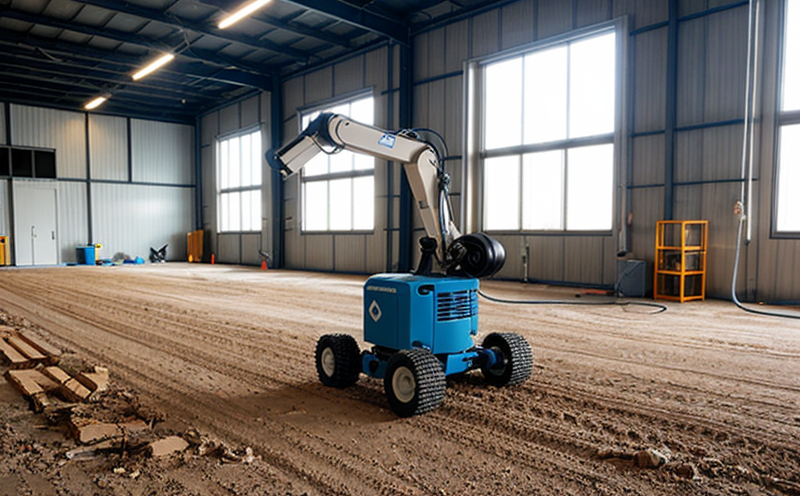ISO 20653 Ingress Protection (IP) Testing of Robotic Systems
The ISO 20653 standard specifies the method for determining the ingress protection rating, commonly known as IP ratings. These ratings provide a concise and consistent way to describe the robustness of electronic equipment against water and solid particles such as dust. In the context of robotics and artificial intelligence systems testing, this standard is crucial for ensuring that robotic systems are capable of operating in challenging environments without compromising their functionality or integrity.
The IP rating consists of two digits: the first digit indicates resistance to foreign objects (dust), while the second digit indicates resistance to water. For instance, an IP67 rating means that the device is dust-tight and can be immersed in 1 meter of water for up to 30 minutes without suffering any damage.
Robotic systems, especially those used in outdoor or industrial settings, are often exposed to harsh environmental conditions. The ISO 20653 IP testing ensures that these robots can withstand exposure to dust and moisture, which is essential for their reliable operation. This testing process involves subjecting the robotic system to various simulated scenarios that mimic real-world conditions, ensuring its durability and safety.
The testing procedure typically begins with a thorough inspection of the robot's design and materials used in its construction. The engineer then proceeds to apply water jets or dust particles according to the specified IP rating requirements. Sensors within the equipment monitor the response of the system during these tests. If the robot passes all the specified criteria, it is deemed compliant with the ISO 20653 standard.
The importance of this testing cannot be overstated in robotics and AI systems that are deployed in various sectors such as automotive, healthcare, agriculture, and manufacturing. Compliance with IP ratings ensures not only the longevity of these systems but also enhances public safety by preventing potential malfunctions due to environmental factors.
In summary, ISO 20653 IP testing is a critical step in ensuring that robotic systems are robust enough to operate safely and effectively in diverse environments. By adhering to this standard, manufacturers can demonstrate their commitment to quality and reliability, thereby gaining the trust of both consumers and regulatory bodies.
| IP Rating | Description | Test Conditions |
|---|---|---|
| IP65 | Dust-tight; protected against low-pressure water jets from all directions | Subject to a 12.0-liter/minute water jet for three minutes. |
| IP67 | Dust-tight; can be immersed in up to 1 meter of water for at least 30 minutes | Immersed in 1 meter of water, held there for 30 minutes. |
| IP68 | Dust-tight; can be immersed in deeper water or under pressure conditions | Subject to a 50-liter/minute water jet for two hours. |
International Acceptance and Recognition
The ISO 20653 standard is widely accepted across numerous countries, including the United States, Europe, Asia, and Australia. Its global recognition ensures that robotic systems tested according to this standard are compliant with international norms and regulations. This uniformity in testing procedures simplifies compliance processes for manufacturers operating internationally.
Adopting ISO 20653 IP ratings is not just beneficial for robotics companies but also promotes a level playing field within the industry. It allows for easier interoperability between different robotic systems used across various sectors, reducing the need for custom solutions that may not meet international standards. This standardization supports global trade and collaboration by ensuring that all parties involved have a clear understanding of the requirements.
Moreover, compliance with ISO 20653 can significantly reduce the risk of product recalls and legal disputes. By adhering to this internationally recognized standard, manufacturers can demonstrate their commitment to quality and safety, thereby enhancing their brand reputation and customer trust.
Competitive Advantage and Market Impact
In today's competitive market, achieving compliance with international standards like ISO 20653 is a key differentiator for robotic system manufacturers. Companies that prioritize IP testing are better positioned to secure contracts with large corporations and government entities, which often require suppliers to meet stringent quality assurance criteria.
Compliance with these standards also opens up new market opportunities in regions where regulatory requirements are becoming increasingly stringent. By demonstrating their commitment to environmental robustness, robotic manufacturers can tap into emerging markets that prioritize sustainability and safety.
The reputation gained from adhering to ISO 20653 can lead to higher customer satisfaction and loyalty. Consumers and end-users who purchase robots with IP ratings are more likely to trust the products' reliability and durability. This can translate into increased sales and brand loyalty, ultimately boosting market share for compliant manufacturers.
Furthermore, compliance with international standards like ISO 20653 not only enhances a company's reputation but also fosters innovation within the industry. The rigorous testing required by these standards encourages engineers to push the boundaries of what is possible in terms of design and functionality, leading to the development of more advanced robotic systems.
Use Cases and Application Examples
The ISO 20653 IP testing is particularly important for robotic systems used in sectors where environmental exposure is a significant concern. Here are some examples:
| Application | Description |
|---|---|
| Agricultural Robotics | Robots operating in fields need to be protected from dust, rain, and other environmental factors. |
| Medical Robots | Routine sterilization of surgical robots requires a high level of water resistance. |
| Marine Robotics | Robots used in underwater exploration must be protected against saltwater corrosion and pressure. |
| Industrial Robotics | Robots working in manufacturing environments need to withstand dust, oil, and chemical splashes. |
The ISO 20653 IP testing is essential for ensuring that robotic systems can function reliably under various environmental conditions. By adhering to this standard, manufacturers can ensure their products are robust enough to meet the demands of these demanding industries.





